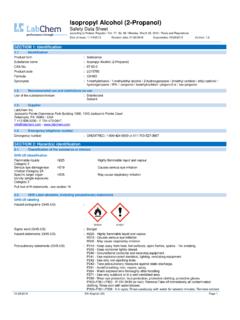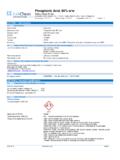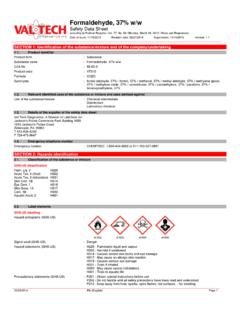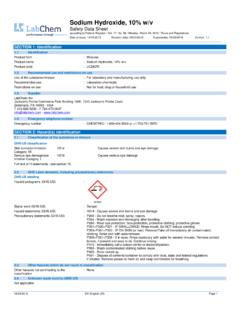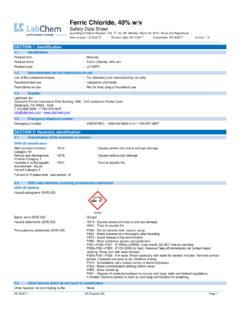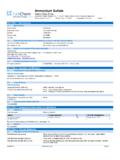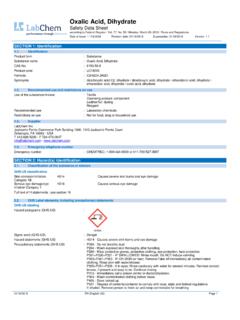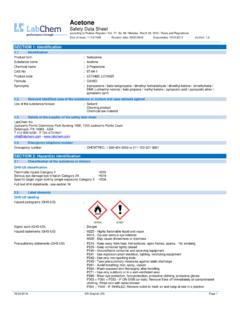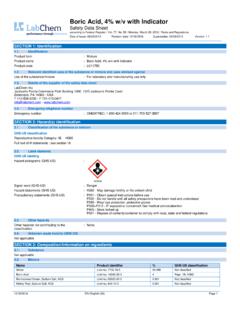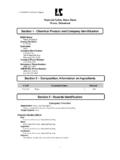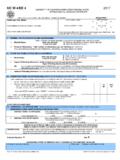Transcription of Sodium Hydroxide, 50% w/w - LabChem Inc
1 Sodium hydroxide , 50% w/w Safety Data Sheet according to Federal Register / Vol. 77, No. 58 / Monday, March 26, 2012 / Rules and Regulations Date of issue: 10/16/2013 Revision date: 02/07/2017 Supersedes: 10/16/2013 Version: SECTION 1: Identification Identification Product form : Mixtures Product name : Sodium hydroxide , 50% w/w CAS-No. : 1310-73-2. Product code : LC24150. Formula : NaOH. Synonyms : caustic soda 50% W/W / soda lye, 50%, aqueous solution / white caustic, 50%, aqueous solution Recommended use and restrictions on use Use of the substance/mixture : Industrial use Recommended use : Laboratory chemicals Restrictions on use : Not for food, drug or household use Supplier LabChem Inc Jackson's Pointe Commerce Park Building 1000, 1010 Jackson's Pointe Court Zelienople, PA 16063 - USA. T 412-826-5230 - F 724-473-0647. - Emergency telephone number Emergency number : CHEMTREC: 1-800-424-9300 or 011-703-527-3887.
2 SECTION 2: Hazard(s) identification Classification of the substance or mixture GHS-US classification Skin corrosion/irritation H314 Causes severe skin burns and eye damage Category 1B. Serious eye damage/eye H318 Causes serious eye damage irritation Category 1. Hazardous to the aquatic H402 Harmful to aquatic life environment - Acute Hazard Category 3. Full text of H statements : see section 16. GHS Label elements, including precautionary statements GHS-US labeling Hazard pictograms (GHS-US) : GHS05. Signal word (GHS-US) : Danger Hazard statements (GHS-US) : H314 - Causes severe skin burns and eye damage H402 - Harmful to aquatic life Precautionary statements (GHS-US) : P260 - Do not breathe mist, vapors, spray. P264 - Wash exposed skin thoroughly after handling. P273 - Avoid release to the environment. P280 - Wear protective gloves, protective clothing, eye protection, face protection. P301+P330+P331 - IF SWALLOWED: Rinse mouth.
3 Do NOT induce vomiting. P303+P361+P353 - IF ON SKIN (or hair): Remove/Take off immediately all contaminated clothing. Rinse skin with water/shower. P305+P351+P338 - If in eyes: Rinse cautiously with water for several minutes. Remove contact lenses, if present and easy to do. Continue rinsing P310 - Immediately call a poison center or doctor/physician. P363 - Wash contaminated clothing before reuse. P405 - Store locked up. 01/29/2018 EN (English US) Page 1. Sodium hydroxide , 50% w/w Safety Data Sheet according to Federal Register / Vol. 77, No. 58 / Monday, March 26, 2012 / Rules and Regulations P501 - Dispose of contents/container to comply with local, state and federal regulations If inhaled: Remove person to fresh air and keep comfortable for breathing Other hazards which do not result in classification No additional information available Unknown acute toxicity (GHS US). Not applicable SECTION 3: Composition/Information on ingredients Substances Not applicable Mixtures Name Product identifier % GHS-US classification Sodium hydroxide (CAS-No.)
4 1310-73-2 50 Acute Tox. 4 (Dermal), H312. Skin Corr. 1A, H314. Eye Dam. 1, H318. Aquatic Acute 3, H402. Water (CAS-No.) 7732-18-5 50 Not classified Full text of hazard classes and H-statements : see section 16. SECTION 4: First-aid measures Description of first aid measures First-aid measures general : Check the vital functions. Unconscious: maintain adequate airway and respiration. Respiratory arrest: artificial respiration or oxygen. Cardiac arrest: perform resuscitation. Victim conscious with labored breathing: half-seated. Victim in shock: on his back with legs slightly raised. Vomiting: prevent asphyxia/aspiration pneumonia. Prevent cooling by covering the victim (no warming up). Keep watching the victim. Give psychological aid. Keep the victim calm, avoid physical strain. Depending on the victim's condition: doctor/hospital. Never give anything by mouth to an unconscious person. If you feel unwell, seek medical advice (show the label where possible).
5 First-aid measures after inhalation : Remove the victim into fresh air. Respiratory problems: consult a doctor/medical service. Remove victim to fresh air and keep at rest in a position comfortable for breathing. Immediately call a poison center or doctor/physician. First-aid measures after skin contact : Wash immediately with lots of water (15 minutes)/shower. Do not apply (chemical) neutralizing agents. Remove clothing while washing. Do not remove clothing if it sticks to the skin. Cover wounds with sterile bandage. Consult a doctor/medical service. If burned surface > 10%: take victim to hospital. Remove/Take off immediately all contaminated clothing. Rinse skin with water/shower. Immediately call a poison center or doctor/physician. First-aid measures after eye contact : Rinse cautiously with water for several minutes. Remove contact lenses, if present and easy to do. Continue rinsing. Immediately call a poison center or doctor/physician.
6 First-aid measures after ingestion : Rinse mouth with water. Immediately after ingestion: give lots of water to drink. Do not induce vomiting. Do not give activated charcoal. Do not give chemical antidote. Immediately consult a doctor/medical service. Call Poison Information Centre ( ). Take the container/vomit to the doctor/hospital. Ingestion of large quantities: immediately to hospital. Rinse mouth. Do NOT induce vomiting. Immediately call a poison center or doctor/physician. Most important symptoms and effects (acute and delayed). Symptoms/effects : Causes severe skin burns and eye damage. Symptoms/effects after inhalation : EXPOSURE TO HIGH CONCENTRATIONS: Dry/sore throat. Coughing. Irritation of the respiratory tract. Irritation of the nasal mucous membranes. FOLLOWING SYMPTOMS MAY. APPEAR LATER: Possible laryngeal spasm/oedema. Risk of lung edema. Respiratory difficulties. Symptoms/effects after skin contact : Caustic burns/corrosion of the skin.
7 Slow-healing wounds. Symptoms/effects after eye contact : Corrosion of the eye tissue. Permanent eye damage. Causes serious eye damage. Symptoms/effects after ingestion : Vomiting. Diarrhoea. Burns to the gastric/intestinal mucosa. Possible esophageal perforation. Bleeding of the gastrointestinal tract. Shock. AFTER ABSORPTION OF LARGE QUANTITIES: Disturbances of consciousness. Chronic symptoms : ON CONTINUOUS/REPEATED EXPOSURE/CONTACT: Dry skin. Skin rash/inflammation. Possible inflammation of the respiratory tract. Immediate medical attention and special treatment, if necessary No additional information available 01/29/2018 EN (English US) 2/9. Sodium hydroxide , 50% w/w Safety Data Sheet according to Federal Register / Vol. 77, No. 58 / Monday, March 26, 2012 / Rules and Regulations SECTION 5: Fire-fighting measures Suitable (and unsuitable) extinguishing media Suitable extinguishing media : EXTINGUISHING MEDIA FOR SURROUNDING FIRES: Adapt extinguishing media to the environment.
8 Foam. Dry powder. Carbon dioxide. Water spray. Sand. Unsuitable extinguishing media : Solid water jet ineffective as extinguishing medium. Specific hazards arising from the chemical Fire hazard : DIRECT FIRE HAZARD. Non combustible. INDIRECT FIRE HAZARD. Reactions involving a fire hazard: see "Reactivity Hazard". Explosion hazard : INDIRECT EXPLOSION HAZARD. Reactions with explosion hazards: see "Reactivity Hazard". Reactivity : Violent exothermic reaction with water (moisture): (increased) risk of fire. On heating: release of corrosive gases/vapours. Absorbs the atmospheric CO2. Violent exothermic reaction with (some) acids. May be corrosive to metals. Reacts with (some) metals: release of highly flammable gases/vapours (hydrogen). Special protective equipment and precautions for fire-fighters Precautionary measures fire : Exposure to fire/heat: keep upwind. Exposure to fire/heat: consider evacuation.
9 Exposure to fire/heat: have neighbourhood close doors and windows. Firefighting instructions : Cool tanks/drums with water spray/remove them into safety. Dilute toxic gases with water spray. Take account of toxic fire-fighting water. Use water moderately and if possible collect or contain it. Protection during firefighting : Heat/fire exposure: compressed air/oxygen apparatus. SECTION 6: Accidental release measures Personal precautions, protective equipment and emergency procedures For non-emergency personnel Protective equipment : Gloves. Face-shield. Corrosion-proof suit. Large spills/in enclosed spaces: compressed air apparatus. Large spills/in enclosed spaces: gas-tight suit. See "Material-Handling" to select protective clothing. Emergency procedures : Mark the danger area. No naked flames. Wash contaminated clothes. Large spills/in confined spaces: consider evacuation. In case of hazardous reactions: keep upwind.
10 In case of reactivity hazard: consider evacuation. For emergency responders Protective equipment : Equip cleanup crew with proper protection. Emergency procedures : Ventilate area. Environmental precautions Prevent soil and water pollution. Prevent spreading in sewers. Prevent entry to sewers and public waters. Notify authorities if liquid enters sewers or public waters. Avoid release to the environment. Methods and material for containment and cleaning up For containment : Contain released substance, pump into suitable containers. Consult "Material-handling" to select material of containers. Plug the leak, cut off the supply. Dam up the liquid spill. Hazardous reaction: measure explosive gas-air mixture. Reaction: dilute combustible gas/vapour with water curtain. Heat exposure: dilute toxic gas/vapour with water spray. Take account of toxic/corrosive precipitation water. Methods for cleaning up : Take up liquid spill into absorbent material, : sand, saw dust, kieselguhr.
